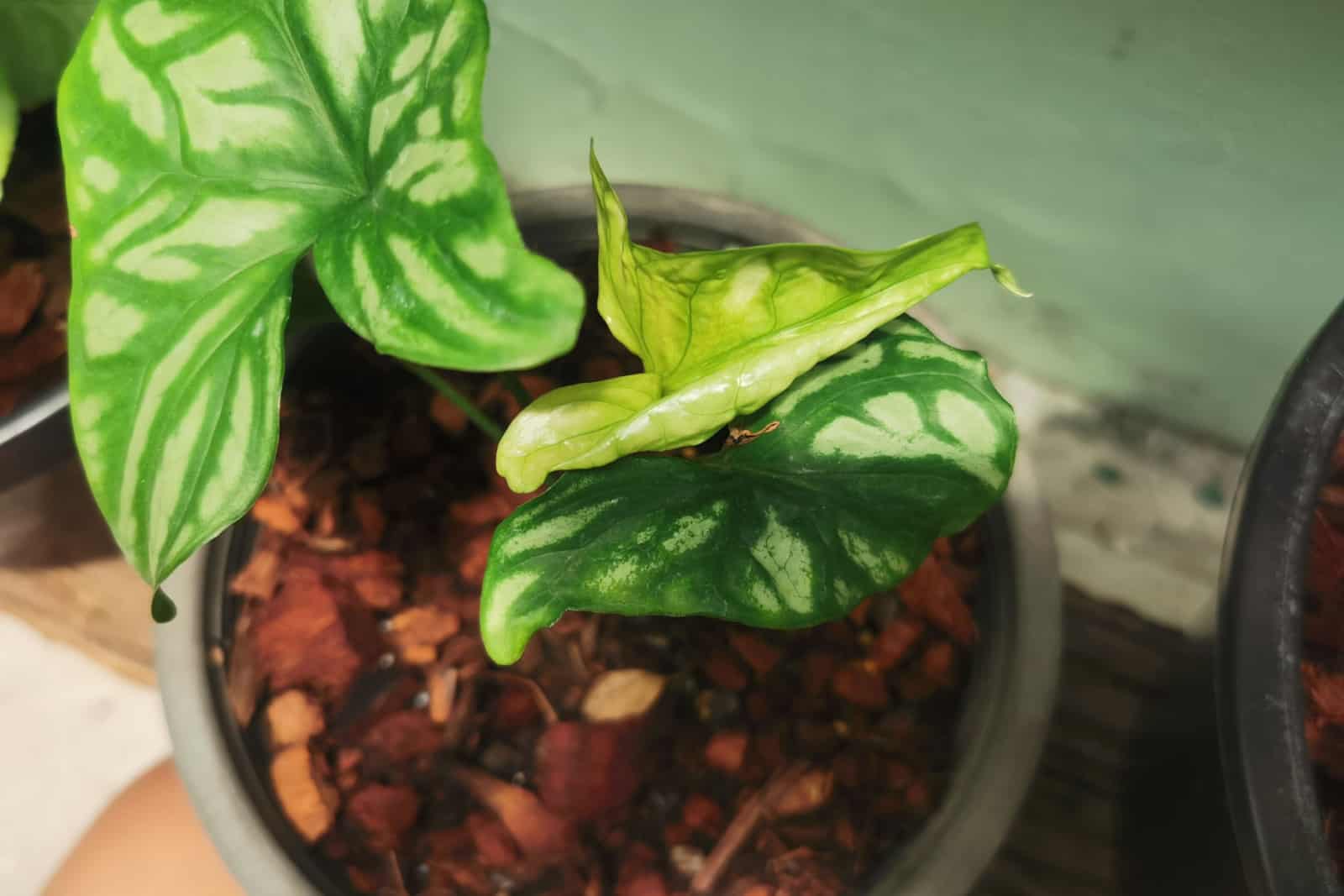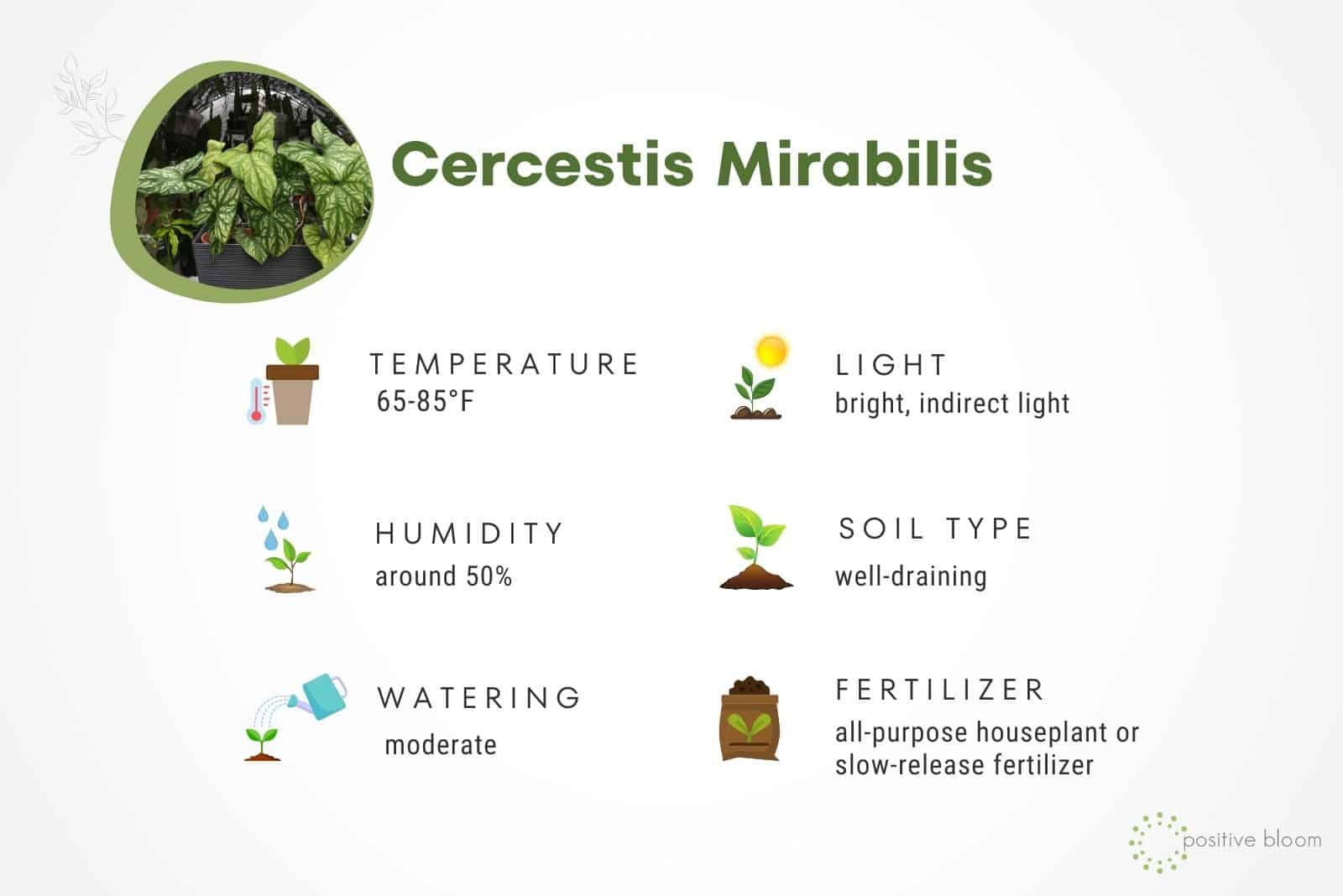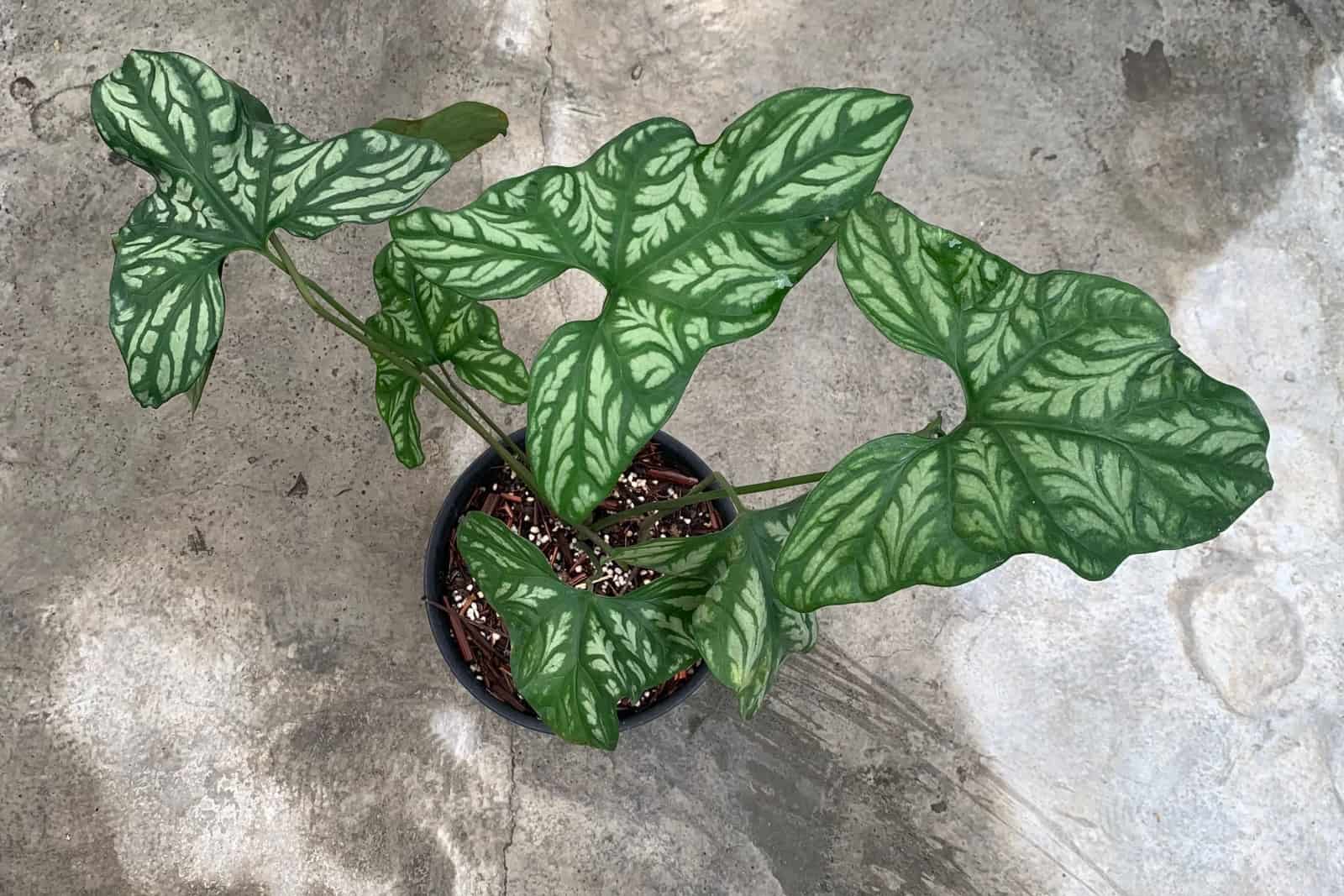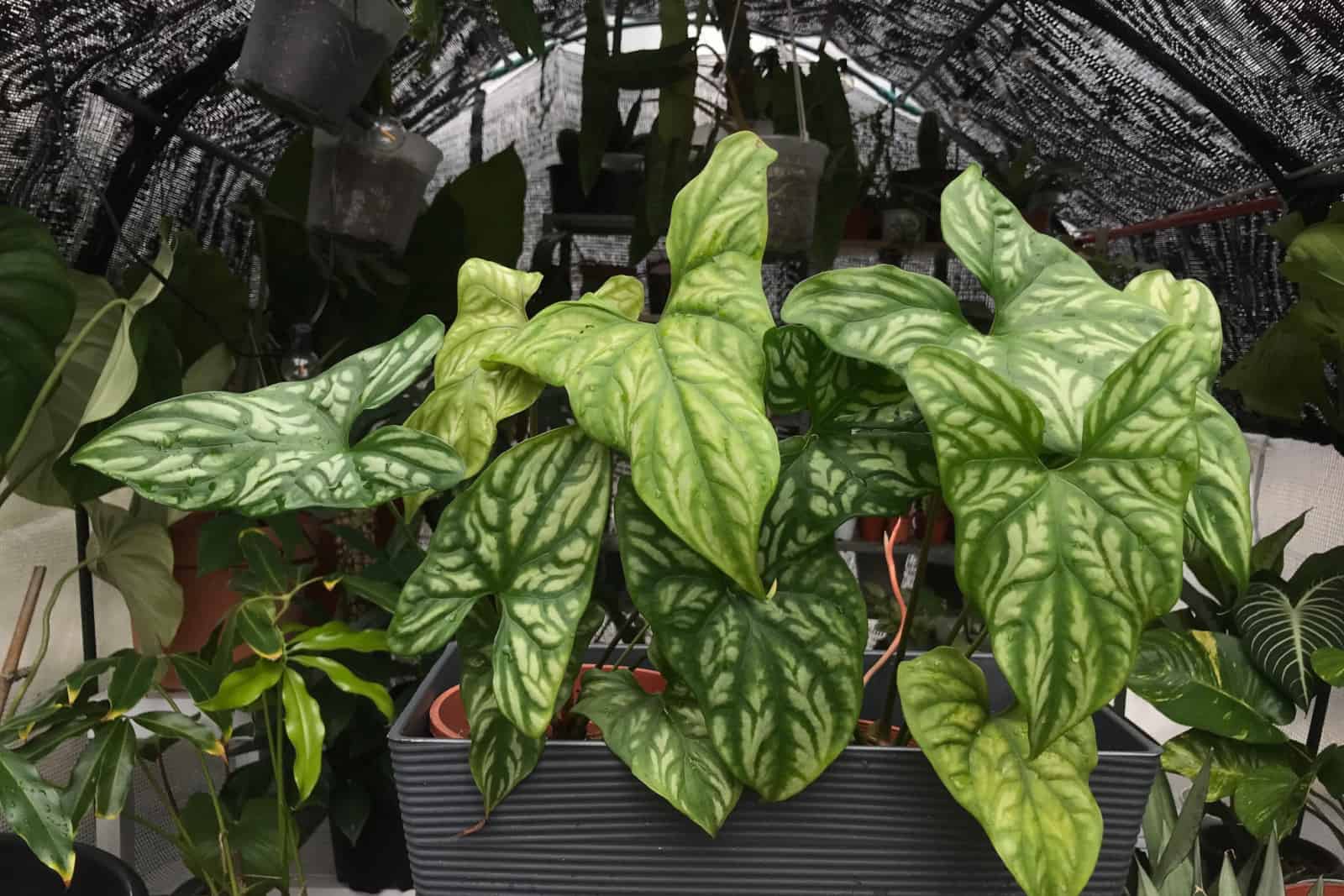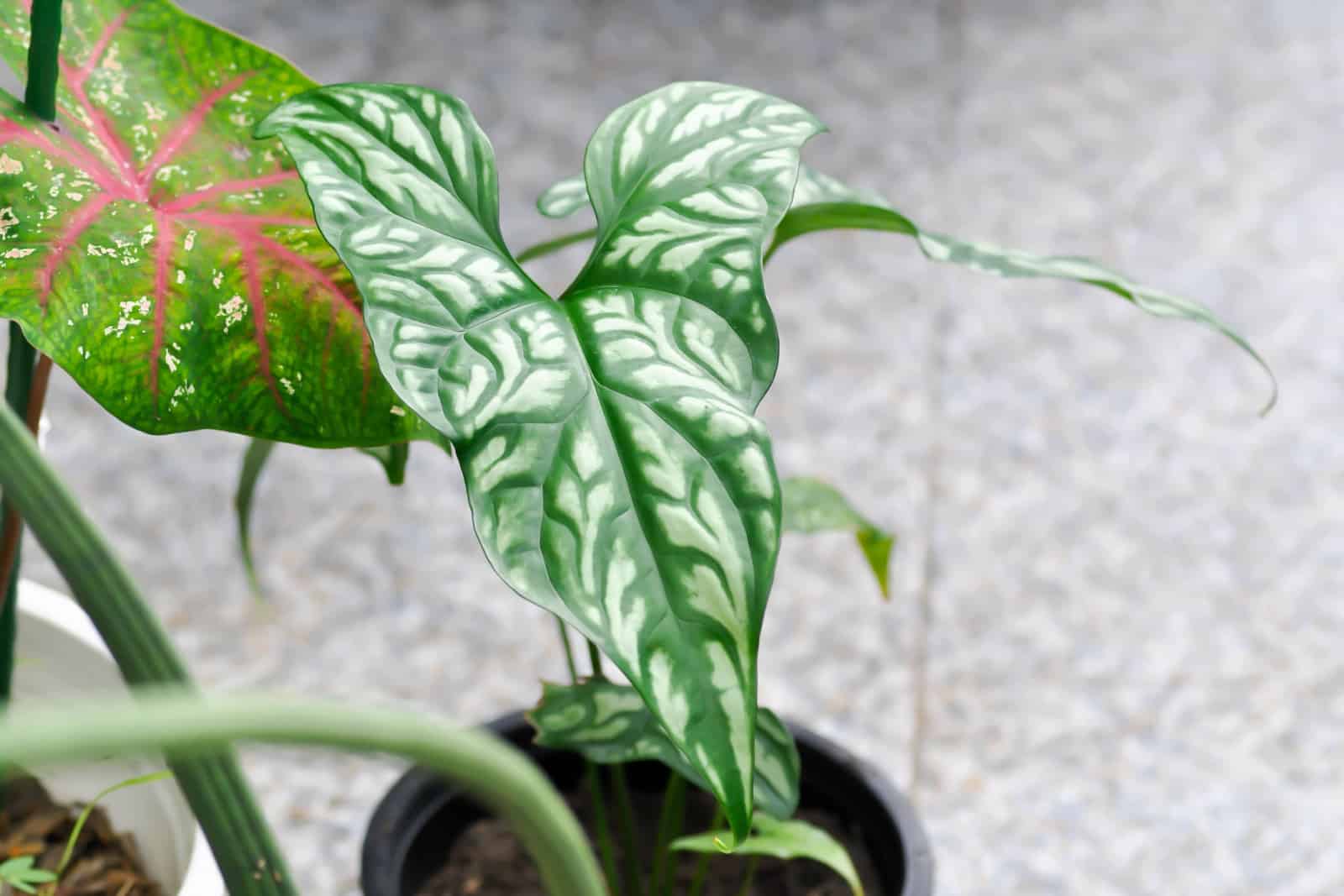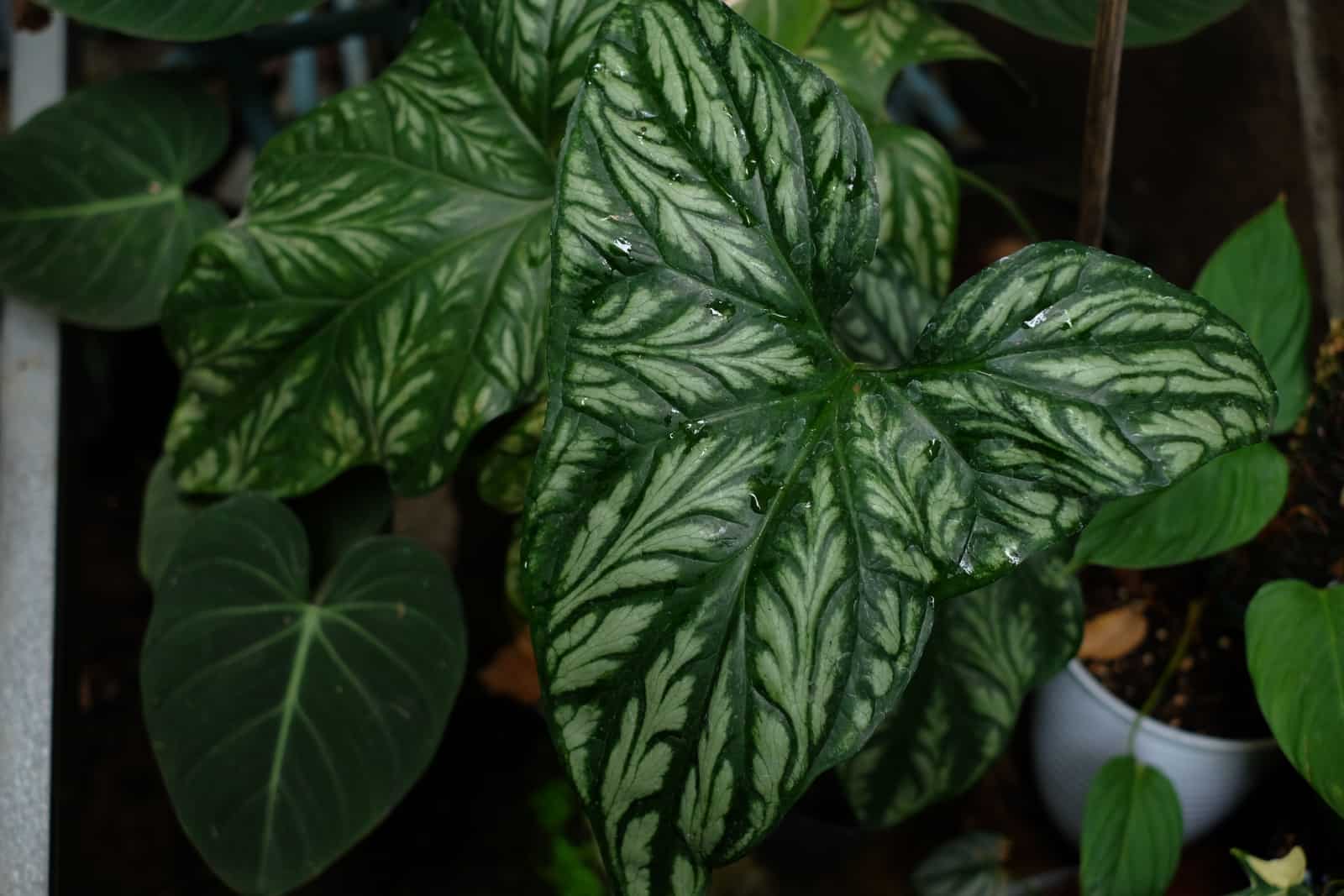Today we’re going to talk about yet another rare tropical plant!
The Cercestis mirabilis, otherwise known as the Wondrous cerces, is an epiphytic climbing plant that belongs to the Araceae family. It is naturally found in African rainforests, though nowadays you can order it online!
This aroid plant has green arrowhead-shaped leaves with silvery or creamy-white variegations. These glossy leaves have prominent veins and can grow quite large, which makes the plant even more alluring.
Even though it is a rarity, this plant still has the same requirements as any other tropical plant.
Here’s some basic info:
[table id=713 /]
Now, let’s find out more about this African beauty!
What’s So Special About The Cercestis Mirabilis?
In its native habitat, the Cercestis mirabilis grows along tall trees that reach up to 15 feet tall. However, when cultivated indoors, it usually grows as a shrub that reaches between 2-5 feet tall. Still, the plant can be pruned to maintain a certain shape and size.
What makes this plant special are those large variegated leaves, which are deeply veined and a lovely green color with silvery variegations all over the surfaces. As they mature, the leaves slowly start losing their variegations.
The leaves are supported by stalks called petioles. These petioles attach the leaf’s basal lamina to the stem. The stem serves as the plant’s axis and supports and distributes water and nutrients after being gathered by the roots.
However, the leaves are not the only thing that make this plant alluring. The Cercestis mirabilis also produces lovely flowers and edible fruit!
Just like Peace lily varieties, this African beauty generates a spathe and spadix. The spathe has a pale green to yellow color and usually grows about 4 inches long. The spadix is shorter and thicker than the spathe (grows about 2 inches).
If pollinated, edible red and pink berries appear. These berries are rich in nutrients and vitamins. In fact, other parts of the plant have been used for medicinal purposes. For instance, the leaves and sap are used to treat liver and heart problems.
How To Take Care Of The Cercestis Mirabilis
It’s quite easy to take care of this plant; all you have to do is water it from time to time and keep it nice and warm. If you live in USDA hardiness zones 9 through 11, you can grow it outdoors.
However, if you live in a region with lower temperatures, then I would suggest you grow it in pots so that you can easily transfer it indoors when the weather gets colder.
Let’s discuss Cercestis mirabilis plant care in more detail.
Soil Requirements
The Cercestis mirabilis plant prefers a well-draining soil mixture. The good news is that you can prepare your own potting soil that these plants will flourish in.
For example, to provide ideal drainage and moisture retention, combine equal parts perlite, orchid bark, and sphagnum moss-based substrate.
Adding some worm castings will also make the soil more fertile and enable you to skip fertilization for some time.
Water Requirements
This African beauty can tolerate some drought, although it thrives when watered regularly. In order to prevent overwatering and root rot, you should only water this plant when the top soil is dry.
Never stick to a rigid watering schedule since there may be times when your plant doesn’t require as much moisture (in the winter or during periods of extremely high humidity, for example), and if you keep watering it at the same rate, you’ll undoubtedly overwater it.
Pour water at the base of the plant until you see the extra coming out through the drainage holes. You should also use filtered or rainwater because these sources don’t include fluoride or chlorine, which can accumulate in your plant and lead to poor absorption of nutrients and moisture.
If tap water doesn’t have a lot of these substances, it can also be used for watering. The chlorine will evaporate if you leave it out in the sun for around 24 hours, making the water a little bit safer to use.
Temperature Requirements
The C. mirabilis is not frost hardy and it doesn’t react well to temperature fluctuations. It prefers growing in temperatures between 65 to 85 degrees Fahrenheit.
If you keep it outdoors and the temperatures get significantly lower, the plant can freeze to death. This is why I suggest you bring it indoors as soon as it gets slightly colder.
You will have to pay attention to temperature fluctuations even indoors. For instance, this plant should not be kept in drafty areas such as next to open windows, air conditioners, or vents.
Keep it away from heat sources as well, including radiators, fire places, or space heaters.
Humidity Requirements
This is a tropical plant that originates from quite a humid environment. However, the C. mirabilis isn’t too picky when it comes to humidity levels.
It can withstand humidity levels as low as 40%, but also high humidity of 90%. However, it usually thrives in moderate humidity of 50%.
There are different methods to improve humidity indoors. You can either invest in a humidifier, mist your plant regularly, or try to make a pebble tray.
Read also: Do Pebble Trays Work For Humidity? All The Answers
Light Requirements
For the C. mirabilis to grow and flourish to its full potential, bright indirect light is necessary. It can’t tolerate too much direct sunlight exposure, so make sure to find a perfect location where it can receive plenty of indirect sunlight.
Given that direct sunlight in the early morning or late afternoon is not intense enough to scorch its distinctive leaves, you should keep it next to an east-facing window.
If you only have west-facing windows, move the plant a few feet away from the window or put up sheer curtains to block the sunlight. You can also use artificial lighting if your home doesn’t have a window that gets plenty of sunlight; just be careful not to put your plant too close or it may burn.
Fertilizer Requirements
This plant is not a heavy feeder, but it will benefit from a bit of fertilizer. It should be fertilized only during the growing season.
You can either use standard indoor plant fertilizer or an organic alternative. You normally need to dilute them to half-strength to avoid burning the roots of your plant.
Slow-release pellets are the best because they feed plants gradually over time. You won’t need to fertilize your C.mirabilis more than twice a year if you use a similar product.
Repotting
The Cercestis mirabilis is a slow-growing plant, so you won’t have to worry about repotting every season. It is recommended to repot this plant once every two to three years or anytime you notice the roots poking out through the drainage holes.
The best time to repot this plant is in spring or summer – this way, it will have enough time to adjust to its new surroundings.
Always go for a plant pot that is 1-2 sizes larger and has drainage holes. Oversized and impermeable containers can cause waterlogging. Prepare the materials before repotting.
When it’s time to repot your plant, you must remove it from its pot and spread the roots if the plant is pot-bound.
Place some potting material in the bottom of the new container, then place your plant in it and fill the planter with substrate until the root system is completely covered. After giving your plant plenty of water, move it to a spot with lots of filtered sunlight.
Pruning
Although it may be tough to trim off those beautiful green leaves, cutting off the top will help you maintain its size and encourage growth.
However, you shouldn’t take away more than a quarter of the plant at once because doing so can cause stress and hinder the plant’s growth
Old, dirty, and diseased foliage should always be removed because they only harm your plant and take up space where new leaves should grow. They also make your plant look sad and lifeless.
Propagation
The C. mirabilis can be propagated by stem cuttings or by using the air layering method. It is quite easy to propagate by stem cuttings, while the air layering method is a bit more complicated. Nonetheless, both methods often have positive outcomes.
Choose the one you like and follow the instructions down below:
Air Layering Method
1. Find a leaf node on the portion of the plant you want to propagate. You can pick a node that is below two leaves so that it will already have lovely foliage when you cut it later.
2. Form a ball out of wet sphagnum moss, wrap it around the node (and the stake), then wrap it in cling film to keep it in place.
3. Mist the moss occasionally and leave the top of the ball open if you’d like. Some gardeners also leave the bottom of the container open so that the roots can extend if they require extra space.
4. Cut below them and move your young plant into a new pot once the root system has developed, which should take around 2-3 weeks.
Stem Cuttings
1. Pick a healthy stem that has aerial roots.
2. Submerge the cutting in water or potting soil that has good drainage. (For water propagation, you should replace the medium whenever it gets foggy.)
3. Place a plastic bag over cuttings that have been planted in soil to trap moisture from the air and encourage root growth.
4. Provide your plant with mild temperatures and an abundance of indirect light. Make sure the potting mix is moist.
Common Issues
The Cercestis mirabilis is not prone to many problems. You won’t run into many issues if you keep it happy and healthy. However, if your plant gets weak, pesky pests might attack it.
It is frequently attacked by pests such as mealybugs, aphids, and spider mites. By consuming its sap, these insects cause it to deteriorate day by day. It’s critical to deal with these annoyances as soon as you notice them.
If the infestation isn’t severe, you can remove them one at a time with a cotton swab dipped in rubbing alcohol. Otherwise, you can pick them off by hand. (Just make sure not to touch your plant with it as the alcohol might burn it.)
If the infestation is severe, you can also apply natural pesticides like neem oil or diatomaceous earth.
Plant diseases such as root rot can affect the plant if it is overwatered. In this case, repot the plant, trim off damaged roots, and apply fungicide. Always use fresh soil and a new pot. Check the soil before watering to avoid giving the plant more water than it needs.
To Sum Up
The Cercestis mirabilis is truly one remarkable plant. Those large triangular leaves can make any room look more lively!
If you get a hold of this plant, make sure to carefully follow the instructions on how to grow it. We are talking about a rare houseplant, so it is important to avoid any type of trouble that might happen to it.
Overwatering, temperature fluctuations, and sunburn are issues that are easily avoided by simply taking good care of your plant.
Once the plant is established, you can try and propagate it!
That’s all, folks. I hope this article was helpful.
Until next time!

